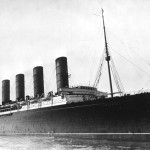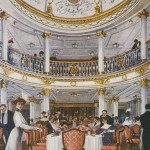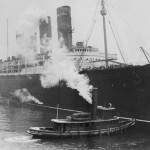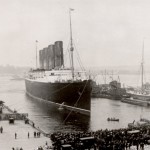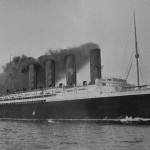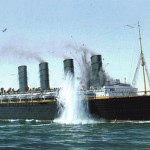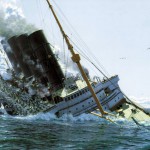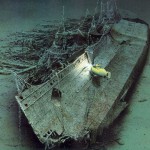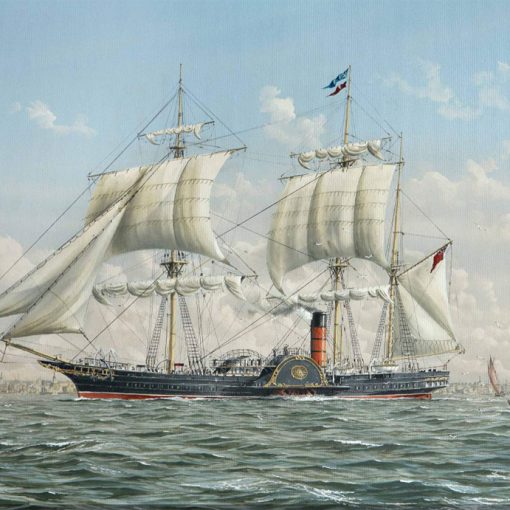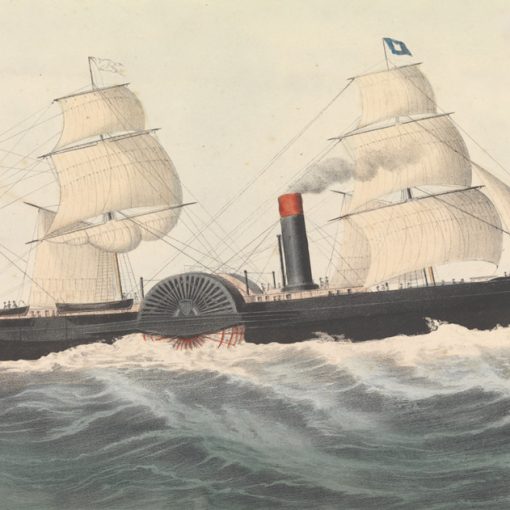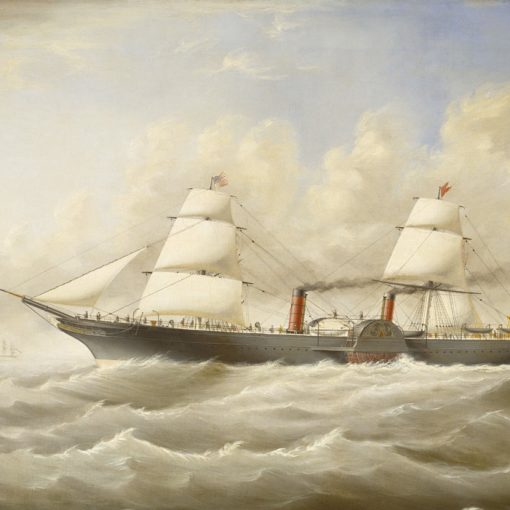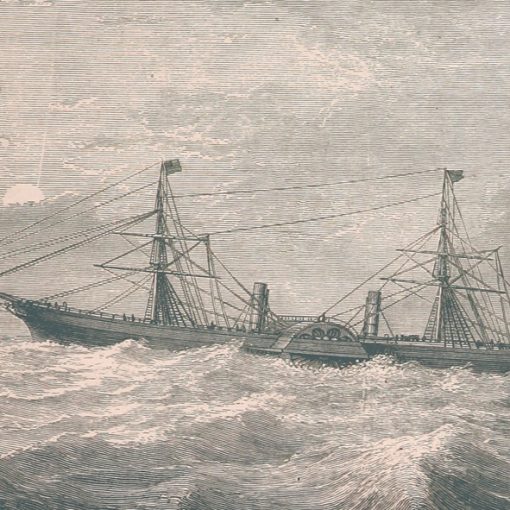1907 – 1915
By the turn to the 20th century, the maritime nation Great Britain was in a state of shock. The empire that had ruled the waves for so long had suddenly been overcome by a nation that in comparison was just in its cradle – Germany. The Blue Riband had been taken from the British by the Kaiser Wilhelm der Grosse, owned and operated by the shipping line Norddeutscher Lloyd, in 1897. And when the Deutschland took the Blue Riband a few years later, it was evident that the supreme ships of the North Atlantic were the German ones. To make matters even worse for Great Britain, it now seemed as if the Empire in the future would have no shipping line with which to give the Germans a match.
With the intention of creating a monopoly on the North Atlantic passenger route, American financier Junius Pierpont Morgan formed the International Mercantile Marine (IMM) in 1901. This consortium soon included such companies as the American Line, Dominion Line, Red Star Line and Holland-Amerika Line and by 1902, Morgan had managed to acquire the famous White Star Line. Although he now controlled one of the two major British shipping lines, Morgan was not yet satisfied. He wanted the Cunard Line as well. Now, it seemed highly unlikely that Cunard would be able to escape Morgan’s clutches. Their rivals, including the German line HAPAG, had already made their peace with IMM. To compete, Cunard needed better, more luxurious and above all faster ships. But for such there was no money.
As a last attempt to keep the company British, the chairman of Cunard – Lord Inverclyde – turned to the British government with a proposition that both parties would benefit from. Taking advantage of British patriotism and the tense political situation in Europe at the time, Lord Inverclyde talked the government into granting the Cunard Line a low-interest loan of £2,600,000. This money would be used to build two new superliners, guaranteed to regain the Blue Riband into British hands. The government would also contribute with an annual operating subsidy of £150,000. In return, Cunard promised to keep the company British and that the two new ships would be constructed so that they in the event of war easily could be converted into armed merchant cruisers.
Now, with the financial difficulties out of the way, Cunard quickly started to draw up the plans for their two new liners. It was obvious that both ships were needed as soon as possible, so two different shipyards were given the task of building one vessel each. The Scottish firm of John Brown and Co. was to build the future Lusitania. Her sister ship, the Mauretania, was to be constructed by the English firm of Swan, Hunter and Wigham Richardson. Although both ships would eventually sail in the Cunard fleet, the companies that now were to build them were competitors. Therefore, each of the two shipyards wanted to have the honour of building the ship superior to its sister. Both companies had been given specifications to meet concerning size and speed, but Cunard also allowed them to make slight modifications of their own. For two years, the engineers of the two shipyards made changes and additions to the original plans, all to improve the performance of ‘their’ ship.
Construction started in 1904, and as the two ships were taking shape, the small differences between them became apparent. The one difference that first may have caught a spectator’s eye was the vents on the superstructure. Mauretania had the traditional cowl vents, bent in ninety degrees on top, whereas her sister was fitted with shorter, hinge-topped, canister-like ones. These ultimately made the decks of the Lusitania seem less cluttered than the ones on her sister, but unfortunately the short hinge-top vents would prove to fail in the test of the North Atlantic, and would need constant replacing.
Originally, the two ships were launched with four three-bladed propellers, but the Mauretania was soon fitted with four-bladed ones after a short time in service, thus improving her performance further, and also making her more distinct from her sister. The rounded stern of the Mauretania also made her five feet longer than her sister, and with her gross tonnage about 400 tons greater than the Lusitania’s, the Mauretania was given the honour of ‘the longest and largest liner afloat’. The two sisters were indeed the latest in shipbuilding technology. With their hull divided into thirty-four watertight compartments, they were claimed to be virtually unsinkable.
From the very beginning, it was decided that these two new superliners would have an operating speed of at least 24.5 knots. Anything less would be unacceptable, since they were intended to break records. To obtain these high speeds at reasonable costs, Cunard decided to take a wild chance and use a new type of machinery. The use of turbines to propel ships was becoming more popular, but it had never been used on ships of this, so far unprecedented, size. To decide whether or not to adopt this new technology, Cunard tested it on a smaller vessel. The Carmania, launched in 1905, was fitted with turbine engines, and her otherwise identical sister, the Caronia, had traditional reciprocating engines. The result of this ‘experiment’ spoke for itself. The Carmania proved to be both faster and more economical to operate than her sister was. With this in mind, Cunard made their decision: The Mauretania and Lusitania would both be equipped with turbine engines.
The first of the two to be launched was the Lusitania, on June 7th, 1906. The event attracted some 20,000 spectators, and as soon as Lady Inverclyde had smashed the bottle of champagne against the ship’s bow and sent the great vessel into its proper element, work began on fitting her out. In accordance with famous Cunard traditions, every effort was made to give each ship a distinct and unique atmosphere, rather than making them as identical as possible, which was the case with for example White Star Line’s Olympic and Titanic a few years later. Although very much alike on the outside, the two new Cunarders would be very different from each other when it came to their interiors. The job of decorating the Lusitania was given to designer James Millar. Working in plaster highlighted with gold leaf, Millar managed to create an environment inspired by the Georgian period and Louis XVI style. This resulted in a light and delicate atmosphere. On the Mauretania, decoration was made by Harold Peto, who was mostly known for having designed the interiors of contemporary English manor houses. By using such materials as oak and mahogany, Peto produced a darker and heavier tone on the Mauretania.
When fitted out, Lusitania had only to go through her sea trials. These were thought to become a mere routine procedure, but during the sea trials a serious flaw in the ship’s construction was detected. At high speeds, the stern of the ship vibrated so violently that it was impossible to inhabit the spaces located in this part of the vessel. Of course, this was not acceptable and Lusitania had to return to her builders to go through extensive renovations. The stern, which contained mainly second class spaces, was strengthened by adding several arches, beams and pillars. Unfortunately, this procedure erased several airy public areas, and turned them into less comfortable, smaller rooms. However, this renovation reduced the shaking considerably, although not completely.
But finally, later than predicted, the Lusitania was ready to depart on her maiden voyage across the North Atlantic. And by the same time, the Mauretania neared completion. Vibration-problems were found on her too, although not as severe as those on her sister, and on the Mauretania the part of the ship haunted by shaking was the forward part of the superstructure. Still, she too was forced to go through some minor changes. By November 1907, the Mauretania was ready for her maiden voyage. Now, Lusitania had already managed to win back the Blue Riband for Great Britain. But soon, Mauretania would take it from her, and although the Lusitania did win it back from her, it eventually found itself back in the hands of the Mauretania, that by now seemed to be the superior ship. These two ocean greyhounds had now crushed the competition, and so superior was the Mauretania that the Blue Riband would remain hers for an incredible twenty-two years.
Through the years that followed, the two Cunarders ruled the waves of the North Atlantic. The Mauretania was undoubtedly the faster of the two, but the Lusitania was more popular among the passengers, probably because of her magnificent interiors. And besides being large and luxurious, the two prides of the Cunard Line were also very reliable. Their turbine engines always seemed to give them the required power, and the shape of the bow was constructed for speed, and speed alone. The way it rose straight up like a knife made the ship break through on-coming waves rather than riding on top of it. But this feature also had its drawbacks. Both of the ships were soon dubbed ‘wet ships’, since they had a tendency to produce great amounts of spray and send it back on the superstructure when they smashed through a wave. During a crossing in 1910, the Lusitania encountered a wave so large that when it hit the bow, it slammed back against the bridge, which was moved a couple of inches aft. The bow of these ships had yet a flaw, however the engineers of the time were not aware of it. Its special shape produced vacuum-pockets on each side, thus slowing the ship down. Ultimately, this cost the Cunard Line thousands of dollars in unnecessary fuel-consumption.
The dominance of the two Cunarders on the North Atlantic continued, but suddenly it was interrupted. In 1914, just after the Cunard Line had launched the new Aquitania, thus turning the previous duo into a trio, World War I broke out. Almost immediately, plans were underway to convert the great ocean liners into armed merchant cruisers. But this concept was soon abandoned. The British Admiralty’s coal bunkers were quickly depleted, because of the great amounts of fuel required by these giant vessels when on patrol. Instead, many of the liners would come to serve their respective countries as either hospital ships or troop transports.
During the first months of the conflict, the Mauretania was confiscated by the Admiralty and stripped of her peacetime interiors. Then she simply would have to wait for a task to be given to her by her new masters. Meanwhile, the Lusitania continued her regular service across the North Atlantic as a non-combatant. It was in this guise that she would eventually meet her fate.
On May 1st, 1915, a warning appeared in several American newspapers. Behind it was the German embassy, which warned people of travelling with ships flying the British flag, since these were possible targets for German U-boats. However, few of the people who had booked passage on the Lusitania were troubled by this warning. The great Cunarder, which was scheduled to depart from New York later that day, was considered very safe. Although six of the ship’s boilers had been shut down to conserve fuel, she could still easily maintain a good speed of 21 knots, making her the fastest ship on the North Atlantic run at the time. It would be a difficult task for a potential U-boat to keep up with her, and in any case, no one really thought that the Germans would actually attack an unarmed passenger liner.
At half past eleven, the whistle blew. The Lusitania, carrying 1,959 people of who a great amount were Americans, was moved out of the quay and set forth upon her journey like so many times before. It was a rainy day, but throughout the voyage the weather improved and on May 7th, the Lusitania, under the command of Captain William Turner, was nearing the Irish coast. Turner had earlier that morning been warned by the British Admiralty that German U-boats were lurking in these waters. One of these was the U-20, under the command of Kapitänleutnant Walther Schwieger. He had already managed to sink three allied vessels during the past two days.
Thirty miles from Cape Clear, the Lusitania encountered fog. Concerned about this, Captain Turner ordered his ship slowed down to 18 knots. Yet, this was an opportunity to cross the last part of the voyage hidden by the fog, arriving safe in Liverpool early the next morning. At about 11.30 a.m., the weather was clearer and the Irish coast was now visible from the Lusitania. A little more than one and a half-hour later, at twelve minutes past two, the track of a torpedo was spotted on the starboard side of the ship. The impact was inevitable and shook the ship violently when it came, just abaft the bridge and below the waterline. Distress calls were sent out by the wireless operators, and officers started to lower the lifeboats. Not long after the torpedo had hit, there was a violent secondary blast that opened a huge hole in the ship’s side. She began to settle rapidly at the head. Panic broke out, and the lifeboats were lowered in utter confusion. In just 18 minutes, the great liner was gone, taking with her 1,195 people, of who 123 were Americans.
Aroused by the stricken liner’s distress calls, many vessels were coming to the rescue, both from the surrounding waters and from the port of Queenstown. But the only thing they could do upon arrival was to salvage the survivors from the water, among them Captain William Turner himself.
Those who had thought that the First World War would be fought in a ‘civilised’ manor had been proven wrong. The Germans had attacked and sunk an unarmed passenger liner, resulting in a great loss of civilian lives. The Americans were in an uproar, and the sinking of the Lusitania was considered a sheer act of barbarism. The event clearly helped to build the public opinion that later would allow the USA to declare war on the German Empire.
Much speculation has circulated about the loss of the Lusitania, mainly about the cause of the violent secondary explosion that made the ship sink so quickly. In an attempt to justify their attack, the Germans always claimed that the Lusitania was carrying secret contraband munitions, which exploded as a result of the torpedo impact. British authorities denied any such cargo being on the Lusitania, and the controversy surrounding those horrifying 18 minutes in the waters off the Old Head of Kinsale would continue into the 21st century.
Today, the Lusitania remains on the location where she once met her ultimate fate. A shadow of the once so glorious liner, she lies on her starboard side on a depth of just 295 feet (90 metres). The hull has collapsed to half its original width, and the superstructure has slid down towards the bottom. The wreck is also entangled in many fishing nets, thus making the site very hard and dangerous to explore. According to Robert D. Ballard, who visited the wreck in the summer of 1993, the only thing recognisable of belonging to the once so proud Cunarder is the forwardmost part of the bow, still pointing up towards the surface. Dr. Ballard did not find any evidence of the suspected secret munitions on the wreck site, but in September of 2008, diver Eoin McGarry used a remotely operated vehicle to enter the wreck. In an area not believed to have carried any cargo, they found a large amount of Remington .303 caliber bullets that were commonly used by the British military during World War I. The find actually validates the German claim that the Lusitania was secretly carrying war supplies, which arguably made her a legitimate military target.
Specifications
- 785 feet (239.8 m) long
- 88 feet (26.9 m) wide
- 31,550 gross tons
- Steam turbines turning four three-bladed propellers
- 25 knot service speed
- Passenger capacity of 2,165 people


